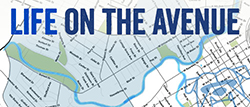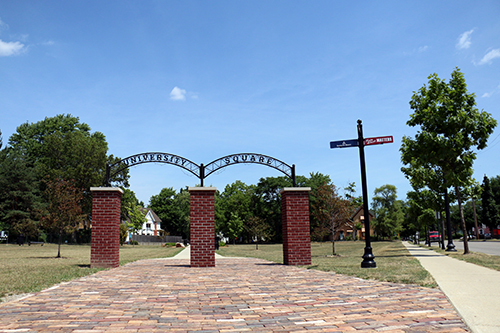
“We get together and plan big things and little things and then we celebrate our successes and learn from our mistakes. That’s how it started.”
#LifeOnTheAvenue is a series that will profile the people, organizations and places in the University Avenue Corridor that make the region unique, compelling and – most importantly – vital to Flint’s bright future. Follow along on social media using the #LifeOnTheAvenue hashtag
A major component of Kettering University's community engagement strategy in the University Avenue Corridor has been fostering a collaborative spirit among a wide range of partners all aimed at making the region vibrant, walkable and continuously progressing.
Carriage Town Ministries, located at 605 Garland Street, has been a highly supportive and engaged partner in that initiative.
The Christian-based homeless mission located several blocks from downtown Flint was one of the founding organizations, along with Kettering, of the University Avenue Corridor Coalition (UACC) in 2012. They have participated in blight removal and beautification of the neighborhood.
“When people start taking care of things, it’s contagious. That’s the way great cities are created and sustained,” said Dallas Gatlin, executive director of Carriage Town Ministries. “The core group of organizations in the UACC really draw energy from each other. Little investments create bigger investments.”
Carriage Town Ministries was founded in 1950 and they’ve been part of the University Avenue neighborhood since 1988. Gatlin became executive director in 2009.
It’s more than a mission. Gatlin said they wanted to create a place where homeless men and women could construct a mentored road from homelessness to sustained self-sufficiency. They wanted to create a community with meaningful things to do all day long and for their residents to better their lives.
“We wanted to be a place where people could come and find purpose and productivity,” Gatlin said. “I’m here because I love being here in this neighborhood. I have a small staff that loves to be here and a giant army of volunteers that love to be here. All of these people have had a part in making this neighborhood part of a better Flint.”
Creating a better place
Carriage Town Ministries understands the purpose of creating a community and giving it and the people there the strength and encouragement to succeed. It was how they approached the community along the University Avenue Corridor.
The University Avenue Corridor Coalition was formed by Kettering in 2012, bringing together residents and area institutions to work collectively to beautify and draw investment to the area. Since then, the group has led community cleanups that involve neighborhood associations, college and high school students, private residents and many others.
The organization’s mission is to transform the region into an attractive and crime-free community that is conducive to sustainable development. Carriage Town was there from the beginning.
What makes the UACC unique is that it relies heavily on forming relationships and encouraging one another, Gatlin said.
“The UACC being called together was a key igniter in neighbors and neighborhoods getting to know each other. We are all getting to know who is along the corridor,” Gatlin said. “We get together and plan big things and little things and then we celebrate our successes and learn from our mistakes. That’s how it started.”
The University Avenue Corridor region extends from McLaren Hospital on the west to the University of Michigan-Flint on the East. It is bounded by Hurley Medical Center and Whaley Children’s Center on the north and the Flint River on the south.
Carriage Town was doing its part to beautify the corridor before the coalition was formed and they have continued to be champions for the corridor.
In 2012, they converted a blighted piece of property into a park on the corner of Grand Traverse and University they called University Square. Planning and fundraising started in 2010.
The site was cleaned up, sidewalks were put in and Kettering University donated benches and trash cans. Arches similar to the Flint arches on Saginaw Street downtown created a welcoming feel into the park, which sits across from the future site of Kettering's Jimmy John’s development.

range of community events near Kettering University's campus.
“It was an overgrown two acres of land filled with gravel and sections of an old parking lots with cracks, tall weeds and broken glass everywhere. It was a desert of blight for a least two decades,” Gatlin said. “We wanted to clean it up and take care of it. Residents and staff of Carriage Town take care of University Square. We wanted it to be simple, knowing that simple meant sustainable.”
Since its creation, University Square has been used for Friday Nights at University Square celebrations, which have brought live music, lawn games and food trucks. Juneteenth celebrations have been held there, as well as a tree lighting ceremony last year for the holidays.
Sitting on Carriage Town Ministries campus is two little free libraries.
Just as anchor institutions like Kettering and Hurley Medical Center have focused on blight removal, so has Carriage Town.
Across the street from the mission, volunteers, staff and residents -- fueled by the support of generous donors -- fixed up a vacant building and turned it into a health screening clinic that opened in January of 2016. Renovation projects not only make the neighborhood look more inviting, but Carriage Town uses them as teach tool for residents there.
“There were pockets of people already doing good things before the UACC was formed. Kettering University has always been a leader in this neighborhood. Shelton Automotive has always taken care of the area around them. Hurley and University of Michigan-Flint have always done a great job, as well. And in the Carriage Town, Mott Park and Glendale Hills neighborhoods, there are homeowners who have for a long time done their part,” Gatlin said. “We made the decision that it was important for us to be good neighbors, treat our neighbors like ourselves and actively be involved.”
Gatlin has watched the corridor change and transform over the years. The streets and sidewalks are better manicured and the medians have been adopted and cleaned up.
“I like the fact that you can come to the University Avenue Corridor at 5 in the morning and run, walk or bike the streets and be safe,” Gatlin said. “You see more people walking around the neighborhoods. The most rewarding thing is to see people out doing things. Everyone in the mix is making it a better place.”
‘The future is bright’
The future of the University Avenue Corridor will be determined by the people who are here, Gatlin said.
“We hope the work that is being done will encourage more investors to come into the community. There are still lots of opportunities and lots of research being done here,” he said. “We have really learned through this process what it means to be a neighbor. The future is bright but there’s still a lot of work to be done.”
Gatlin is hopeful for the future of the University Avenue Corridor. The UACC is a big part of that, along with the community advocates.
“That’s the beauty of it. It’s really a big neighborhood comprised of many little neighborhoods with their own character,” Gatlin said. “Getting to know your neighbors is key. Listen to each other. We can’t sit back and do nothing. We need to keep going. Flint became a great city because people did the hard things that they wouldn’t benefit from but future generations would. That’s what we need to do now. We need to do the hard things.”